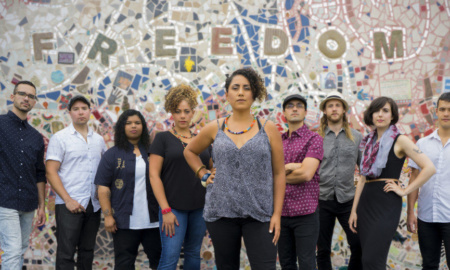
- Enter the Microbiome
- The Microbiome, Health, and Disease
- Antibiotic Overuse Leads to Antibiotic Resistance
- One Nation Under Antibiotics: How Did Antibiotic Resistance Happen?
- Antibiotics: From the Farm to Your Table
- How to Stick a Fork in Antibiotic Resistance
- Here are 5 simple steps you can take to reduce antibiotic resistance:
- Our Immune System and the Global Ecosystem
“The reason I have trouble finding a good antibiotic when my son has an ear infection is directly related to the cost of [that] cheap hamburger.”
– Michael Pollan in Modern Meat, Frontline
What would happen if our children’s serious infections no longer responded to antibiotics? If an infection in the uterus of a mother who has recently given birth couldn’t be treated with antibiotics? If there were no longer a cure for meningitis, or any number of life threatening infections?
The magnitude of this reality is upon us as we enter into an era that is, according to major public health organizations such as the Centers for Disease Control and Prevention and the World Health Organization, defined by the global health crisis called antibiotic resistance.
What is antibiotic resistance? In short, it means that infectious bugs are outwitting our antibiotics to the point that the antibiotics we have are no longer effective against them, and even many previously benign bacteria and viruses have now become pathogenic – or disease causing.
The bad news is that there are not many new antibiotics on the horizon to solve this problem. The good news is that much of the antibiotic resistance we are facing can be reversed if we do it fast. This requires that we not only get more savvy in our medical use of antibiotics, but that we bring voting antibiotic-free to our forks!
Enter the Microbiome
Perhaps the most exciting scientific revelation of this century will turn out to have been the realization that the health of our gut microbiome is central to our overall health as human beings. Not just because its functions are fascinating and more intrinsic to human health than we ever imagined, but because the microbiome may just be the missing link that, until now, has prevented a broad medical and scientific acceptance of the fact that we are not separate from the natural world, and cannot dominate it into submission and still expect to maintain our own health.
The belief that we can override nature, which has prevailed in medicine and science since Descartes, is failing us.
The Microbiome, Health, and Disease
The microbiome is elegantly defined as “the ecological community of commensal, symbiotic, and pathogenic microorganisms that share our body space.” The human body amazingly houses over 10 times more microbial cells than human cells. Most of these “bugs” are harmless; many are helpful.
Emerging science is illuminating the myriad roles that these organisms play in our well-being. They protect us from unwanted and dangerous microorganisms, participate in metabolism, detoxification, and even in our mood through the “gut-brain” connection. This latter pathway has led the way into research on “psychobiotics,” the role of gut microflora in depression, anxiety, and even schizophrenia.
A predominance of the right type of gut flora species, Bifidobacterium, helps protect us from becoming overweight, while an overabundance of another less friendly bug, Clostridium difficile, can lead to death from diarrhea in a matter of days.
Here’s just a brief list of the conditions associated with “dysbiosis” – having too much of the wrong kind of gut flora, not enough of the right kind, or both.
- Antibiotic-associated diarrhea
- Asthma/allergies
- Autism
- Depression and anxiety
- Diabetes
- Eczema
- Gastric ulcers
- Inflammatory bowel diseases
- Malnutrition
- Obesity
The human microbiome may also play a role in autoimmune diseases including rheumatoid arthritis, multiple sclerosis, fibromyalgia, and even certain cancers.
In a country where it is predicted that 1 in 3 people will have diabetes by 2050, 70% are already overweight or obese, and where C. diff is one of the leading causes of deaths in hospitals – including of people who came in uninfected with that bug – the role of the microbiome in health is nothing to “poo-poo at,” excuse the bowel pun.
However, the health of our guts has been under siege for nearly 60 years, and now the danger is getting worse. There has been one primary suspect in the crime against the human microbiome that we now know is guilty – antibiotic overuse.
Antibiotic Overuse Leads to Antibiotic Resistance
While the advent of antibiotics appeared to have tamed infectious diseases for several decades, infectious organisms have now largely outwitted these drugs. Many have become “superbugs” that we can now barely tame. Their names include E.coli, C. diff, MRSA, drug-resistant TB (tuberculosis), pneumonia, and N. gonorrhea, to name a few.
At the same time, we have unwittingly damaged one of our own major lines of defense against both acute infection and chronic disease – our human microbiota – with these same antibiotics, and as a result, are experiencing unprecedented rates of the chronic diseases I listed above.
The overuse of antibiotics that began in the last century has led to massive antibiotic resistance. We have upset the delicate balance of microorganisms in our environment with the ubiquitous presence of antibiotics, creating new strains of organisms that were not previously harmful, and making previously harmful ones more virulent.
The extent of this damage is that in the US alone an estimated 23,000 deaths occur each year solely due to infections that antibiotics are no longer able to treat. This is to the tune of about $20 billion in extra health care costs to the country – annually. The problem is much worse in terms of suffering and lost lives in less economically privileged countries. Last year in India alone, 58,000 infants died of an antibiotic resistant infection.
According to both the CDC and the WHO, antibiotic resistance is now the single most pressing global health problem. We are on the verge of an international emergency, as the antibiotics we have relied heavily on to treat life-threatening infectious diseases are failing to work, and even more serious diseases are emerging as a direct result of resistance.
Seeing our health as connected to how we treat our environment becomes a necessary new way of thinking for all of us, one that requires we pay attention to what we do to the planet’s ecosystem if we plan to stay healthy on it for much longer. The great lesson in all of this is that in health and ecology, everything is connected.
One Nation Under Antibiotics: How Did Antibiotic Resistance Happen?
In the 1940s, the advent of antibiotics was, for good reason, seen as nearly miraculous. Previously untreatable life-threatening infections yielded under the power of a powder, pill, or liquid that one could get from their doctor, and eventually, their local pharmacy. Penicillin was the first of these “magic bullets.”
These miracle drugs were seen as both benign and as a cure-all for pretty much everything. They even made their way into agriculture as crop sprays and food preservatives, and into animal feeds. They were used to treat blights in apple, pear, and walnut trees. Tetracycline was sprayed onto chipped ice and added to hamburger meat. By 1955, 12 percent of 475 milk samples from dairy farms around the US were found to be contaminated with penicillin.
It wasn’t long before a small group of concerned scientists became concerned that the overuse of this important class of drugs would lead to a backlash. Even Alexander Fleming, who is credited with the discovery of penicillin, warned about the potential for antibiotic resistance as early as 1945.
You see, bacteria are highly indiscriminate social creatures. They mate by trading all kinds of information with numerous “sexual” partners including intel on how to become resistant to antibiotics. One bug can teach another bug how to become resistant to 5 different antibiotics in one “embrace.” They do this not only within their own species, but interspecies. So an E.coli can teach Salmonella new tricks – right in your gut or the gut of a cow that got some antibiotics on the feedlot.
In addition, like all other life forms, bacteria are continually evolving, and they can do so rapidly in your very own digestive system, on your skin, in your sinuses, and just about everywhere else. So it doesn’t take long for simple Staphylococcus aureus bug to become a “Super Staph” that is resistant to an antibiotic, like say, methicillin. And voila, we’ve got MRSA (methicillin-resistant Staphylococcus aureus). Now think about what would happen if some of these bugs started talking to other bugs – like Anthrax!
Antibiotics are also widely inappropriately prescribed, meaning the wrong drug is given for the bug, and they are wildly overprescribed, meaning given when no antibiotic is needed, for example for viral infections, non-serious bacterial infections, or for just a fever and a cough when the type of infection hasn’t yet been identified.
As many as 30% of US born babies are exposed to an antibiotic before or at the time of birth either indirectly through the mom (i.e., at the time of a cesarean section), or directly after birth. By the age of 18 years old, most children in the US receive between 10 and 20 courses of an antibiotic. Approximately 50-70% of the time when treating common infections in kids and adults, antibiotics are unnecessarily prescribed in doctor’s offices, emergency departments, and even in hospitals.
Why do so many doctors and other licensed health professionals overprescribe antibiotics? There are 4 reasons that typically lead to this: 1) They’re afraid to get sued if a patient’s health goes south and they hadn’t prescribed an antibiotic, 2) They believe that patients expect to be prescribed antibiotics (which is often true), 3) They don’t feel they have the time in the context of a usually hurried medical appointment to explain the problem of antibiotic overprescribing to patients – it’s quicker and easier to write the script, 4) They don’t know what to prescribe as an alternative.
They often use the wrong drug for the bug because they haven’t taken the time to look at the specific antibiotic resistances in their community, which is important, because these vary sometimes by region, sometimes even by hospital.
This overuse of antibiotics by the medical profession, as inexcusable and dangerous as it might be, is just one part of the story.
Antibiotics: From the Farm to Your Table
Here’s how antibiotic resistance spreads from the farm to your table:
- RESISTANCE: All animal carry bacteria in their intestines. Antibiotics given to food-producing animals kill most of the bacteria but resistant organisms survive and thrive.
- SPREAD: Food products are then laden with resistant bacteria that contaminate produce through soil and water, contaminate food preparation surfaces (including your hands, countertops, and cutting knives, for example), and resistant bacteria are spread through the environment through animal poop.
- EXPOSURE: People get sick with resistant infections from eating contaminated foods or having contact with a contaminated environment (which has caused sometimes severe resistant infections in farmers and their families).
- IMPACT: Resistant infections can cause mild to severe, and even life-threatening illnesses, and even death. These infections can be from organisms in the food itself, or from other infections that have becoming resistant to antibiotics through interspecies spread of resistance information.
According to a study done by the Union of Concerned Scientists, well over half of the antibiotics used in the US go into animals being raised for food, usually via their feed. This is to the tune of billions of dollars in annual profit to the pharmaceutical industry. It’s actually impossible to know the volume of antibiotics that ends up in animal feed because the pharmaceutical industry has historically, persistently, and effectively kept this data under wraps. There is no federal regulation that requires disclosure of this information to the public.
Now you might think, well of course, that makes sense. Animals can get sick, and we don’t want infected meat. But there are two important things to consider here:
- Most of the time antibiotics are not being used to treat animals who have become sick; they are being used to prevent infections that arise as a result of the unhealthy methods used to raise them, for example corn-feeding cattle and overcrowding.
- Most of the antibiotics that go into raising animals for red meat are to make them grow faster – a well known “side-effect” of giving antibiotics in “subtherapeutic doses.”
Antibiotics used in food-producing animals are a major contributor to antibiotic resistance in humans. Resistant bacteria contaminate the foods that come from these animals, and those who consume these foods can develop resistant infections, and also pass these resistant organisms on to those with whom they are in close contact, spouses and children, for example, just by living in close proximity and sharing food and intimacy.
Food poisoning has also gone up with the increase in antibiotics use in the animal industry. For example, the potentially deadly strain of E. coli 0157 that became famous when 700 people became sick and four children died from Jack-in-the-Box food in the 1990s wasn’t even isolated from animals until the 1980s, and doesn’t exist in the gut of grass-fed animals – only in those that are corn-fed. Campylobacter, an organism commonly found in poultry, is now largely resistant to the antibiotic that was previously relied on to treat it – Ciprofloxacin – largely because the Campylobacter is antibiotic resistant from the chickens being treated with antibiotics! And Salmonella outbreaks have significantly increased in number and severity in the past few decades, and are also more resistant to treatment.
While the CDC strongly urges the US FDA to “promote the judicious use of antibiotics that are important in treating humans” by only using such antibiotics in food producing animals “under veterinary oversight and only to address animal health needs and not to promote growth,” and in the past even the FDA has advocated such restrictions, the Department of Agriculture, undoubtedly nudged by the meat and pharmaceutical industries, has hindered efforts to make progress in controlling inappropriate antibiotic use in the industry.
Approximately 80-90% of the antibiotics ingested by humans and animals are not broken down. Rather, they pass through the body in an active form, retaining their ability to affect bacteria and promote antibiotic resistance even after they enter the soil or water as waste. In a vicious cycle, we continuously disrupt the delicate balance in our ecosystem.
How to Stick a Fork in Antibiotic Resistance
Stick a fork in it: Meaning that something is definitively finished or can be stopped. (Urban Dictionary)
While we are already experiencing massive global effects of antibiotic resistance on human health, if we act now, en masse, the situation is reversible. While this inevitably requires broad-scale policy changes, and a re-envisioning of the cost-savings of factory-scale animal food production to factor in the massive costs of antibiotic resistance, we can each make it our personal commitment to challenge this problem.
Here are 5 simple steps you can take to reduce antibiotic resistance:
- Eat less meat: A diet rich in plant-based protein sources such as legumes, beans, nuts, and seeds, with small amounts of meat as a complement can absolutely provide adequate dietary protein. If you do eat meat, consume only a recommended healthy portion size, which is typically 4-6 oz. of red meat or poultry (about the size of a deck of cards or the palm of your hand).
- Eat only grass-fed, antibiotic-free animal products (meat, poultry, and dairy): When you do eat animal products, support farmers who are raising their animals sanely and humanely. This may cost more in the short run, but the cost to your own health and society – well, priceless.
- Get Smart: The Michael Pollan quote at the beginning of this article accurately connects antibiotic resistance to the production of cheap meat (50% of all meat in the US goes into hamburger). But the first half of his statement normalizes an insidious issue – most childhood ear infections do not require antibiotic treatment. Learn when an antibiotic is needed – and when it’s not, which is most of the time. The CDC has an excellent website, GET SMART, devoted entirely to reducing antibiotic resistance by educating patients and physicians about which common respiratory infections, including ear infections, require antibiotic treatment. Add this link to your bookmarks for a quick reference next time you or a family member has a cold, cough, fever, or other signs of a respiratory infection, or if your doctor recommends an antibiotic that you’re not sure you need.
- Use Natural Alternatives to Antibiotics: Quite a number of natural products, including herbal medicines and nutritional supplements, have shown efficacy in reducing symptoms associated with upper respiratory infections (coughs, colds, fever, sore throat, ear infection, bronchitis) without promoting resistance. Umckaloabo, for example, has been shown to be effective in reducing the duration and severity of coughs and bronchitis, and the need for antibiotics in both adults and children; Echinacea reduces the recurrence of colds. Elderberry syrup reduces the duration and severity of flu, thus reducing the likelihood of a secondary infection requiring antibiotics. Zinc can reduce respiratory infection symptoms, and Xylitol syrup can reduce ear infections in babies and children.
- Wash hands regularly with plan soap and water, and gives hugs instead of handshakes: Both of these are simple methods for reducing the frequency of colds, etc. Fewer colds means less likelihood of an antibiotics prescription!
Our Immune System and the Global Ecosystem
The ramifications of antibiotics overuse on our personal health go beyond those I have described here; they interfere with metabolism, increase the likelihood of developing obesity through many mechanisms, and contribute to something called oxidative stress which can cause inflammation – all of these carry major health risks. The global picture of antibiotic resistance is also dire. By acting locally, we not only improve our internal immunity and ecosystems, but we have the potential to impact our global ecosystem not just for ourselves, but also for generations to come. Our actions today can be lifesaving for many tomorrow.


